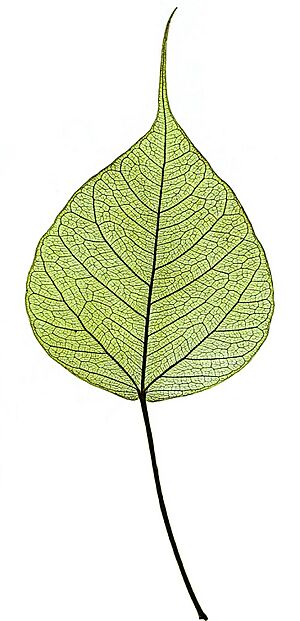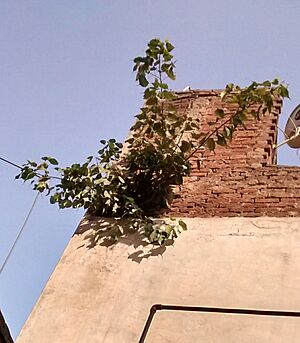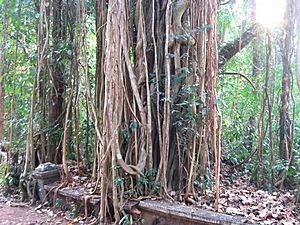Ficus religiosa facts for kids
Quick facts for kids Sacred fig |
|
|---|---|
 |
|
| The tree trunk and distinctive heart-shaped leaves | |
| Scientific classification | |
| Genus: |
Ficus
|
| Species: |
religiosa
|
| Synonyms | |
|
|
The Ficus religiosa is a special type of fig tree often called the sacred fig. It grows naturally in places like India, Bangladesh, and parts of Southeast Asia. You might also hear it called the bodhi tree, peepul tree, or ashvattha tree.
This tree is very important in three major religions that started in India: Hinduism, Buddhism, and Jainism. People who follow these religions often think of it as sacred and sometimes meditate under its branches. A famous sacred fig tree is where Gautama Buddha is believed to have found enlightenment. The sacred fig is also the official state tree for Odisha, Bihar, and Haryana in India.
Contents
About the Sacred Fig Tree
The sacred fig is a very large tree. It can grow up to 30 meters (about 98 feet) tall, which is like a 10-story building! Its trunk can be as wide as 3 meters (about 10 feet). The tree's leaves are shaped like a heart with a long, pointy tip. They are about 10 to 17 centimeters (4-7 inches) long.
The tree produces small figs, which are its fruits. They are about 1 to 1.5 centimeters (less than an inch) wide and change from green to purple as they ripen.
How Long Do They Live?
Sacred fig trees can live for a very long time, usually between 900 and 1,500 years. One of the oldest known sacred fig trees is the Jaya Sri Maha Bodhi tree in Sri Lanka. It is thought to be more than 2,250 years old!
Where Sacred Fig Trees Grow
The Ficus religiosa naturally grows across much of the Indian subcontinent, including Bangladesh, Bhutan, Nepal, Pakistan, and India. It also grows in parts of Southeast Asia like Thailand and Myanmar.
People have also planted these trees in many other tropical places around the world, such as Iran, Florida, and Venezuela.
How Sacred Fig Trees Live
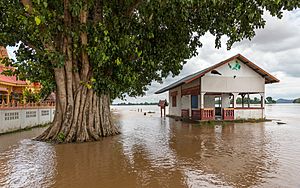
Sacred fig trees can grow in many different places, from low areas near the sea (10 meters or 33 feet) up to mountains (1,520 meters or 5,000 feet). They can handle temperatures from 0 to 35 degrees Celsius (32 to 95 degrees Fahrenheit). They grow best in deep, sandy soil that drains water well, but they can also grow in rocky places.
Tree Helpers: Fig Wasps
The sacred fig tree has a special relationship with a tiny insect called the Blastophaga quadriceps wasp. This wasp helps the tree make seeds by carrying pollen from one flower to another. In return, the wasp lays its eggs only on this type of tree. It's a perfect partnership!
Climate and Soil
The sacred fig is very tough and can grow in many different climates. This includes places with lots of rain all year, places with wet and dry seasons, and even some warmer areas with dry summers or winters. It can also grow in many different types of soil.
In some parts of China, these trees are found growing at altitudes of 400 to 700 meters (1,300 to 2,300 feet). In India, where they are native, they grow both in the wild and in planted areas up to 1,520 meters (5,000 feet) high.
When They Spread Too Much
Unlike some other fig trees that grow on other plants, the sacred fig's roots can grow inside the stem of a support tree. This can eventually split the support tree from the inside.
Because the sacred fig grows fast, can live for thousands of years, and can grow in many different climates and soils, it has been listed as an "environmental weed" in some places. This means it can spread easily and take over areas, sometimes harming other plants. For example, in Hawaii, it has a high risk score, meaning it could become a major problem there.
Sacred Fig in Culture and History
The sacred fig tree has been important to people for a very long time. The oldest known signs of its importance are from about 4,700 years ago! People from the ancient Helmand culture in Afghanistan used to draw peepal leaves on their pottery.
The ancient Indus Valley Civilisation also respected this tree and its leaves, using them in their religious art.
In Hinduism
Followers of Hinduism consider the peepal tree very sacred. Hindu holy people, called Sadhus, often meditate under these trees. Hindus also walk around the tree in a circle, called pradakshina, as a way of showing respect. They usually walk seven times while saying a prayer that means "salutation to the king of trees."
In the Hindu holy book, the Bhagavad Gita, the god Krishna says he is the Peepal tree among all trees. In India, the highest civilian award, the Bharat Ratna, is shaped like a leaf from a Peepal tree.
In Buddhism
The sacred fig is especially famous in Buddhism. Gautama Buddha found enlightenment (a state of deep understanding) while meditating under a Ficus religiosa tree. This happened in a place now called Bodh Gaya in India.
The original tree there was destroyed and replaced many times. However, a branch from that first tree was planted in Anuradhapura, Sri Lanka, in 288 BCE. This tree, called Jaya Sri Maha Bodhi, is still alive today and is the oldest human-planted flowering plant in the world!
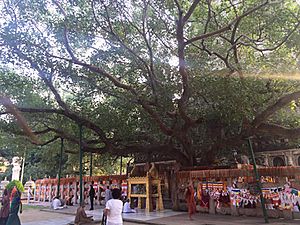
In Theravada Buddhist countries, the large trunks of these trees often have Buddhist shrines or altars nearby. Not every Ficus religiosa is called a Bodhi Tree. A true Bodhi Tree is traditionally one that can be traced back through its parent trees all the way to the original tree under which Buddha gained enlightenment.
Growing Sacred Fig Trees
Special plant nurseries grow sacred fig trees to be used as decoration in gardens and parks in warm, tropical places. These trees love hot, humid weather and lots of sunlight. They can grow in most types of soil, but a rich, loamy soil is best. When planting, the soil should have a pH of 7 or lower. While they can be grown indoors in pots, they do best outside. Young trees need good care and plenty of water.
Like many fig trees, the sacred fig is also popular for Bonsai training, where they are grown as small, shaped trees in pots.
In some countries, like the Middle East, they are often planted along roadsides and avenues. In places like the Philippines and Nicaragua, you can find them in parks and along sidewalks.
In Thailand, these trees, called "Pho" trees, grow everywhere. But in the Wats (temples), they are especially respected and are often hundreds of years old with very wide trunks. People sometimes buy "mai kam sii," which are supports that look like crutches, and place them under the tree's branches. This helps support the old trees and also helps fund the temple.
Uses of the Sacred Fig
The sacred fig tree has been used in traditional medicine for a long time to help with about fifty different health problems. These include things like asthma, diabetes, stomach issues, and infections.
Farmers also use the trunk of this tree as a tool to level the soil in their fields after harvesting seeds. They attach the rectangular trunk to tractors to smooth out the ground.
See also
 In Spanish: Higuera sagrada para niños
In Spanish: Higuera sagrada para niños
- Bodhi Tree
- Shitala Devi
- Ficus Ruminalis


